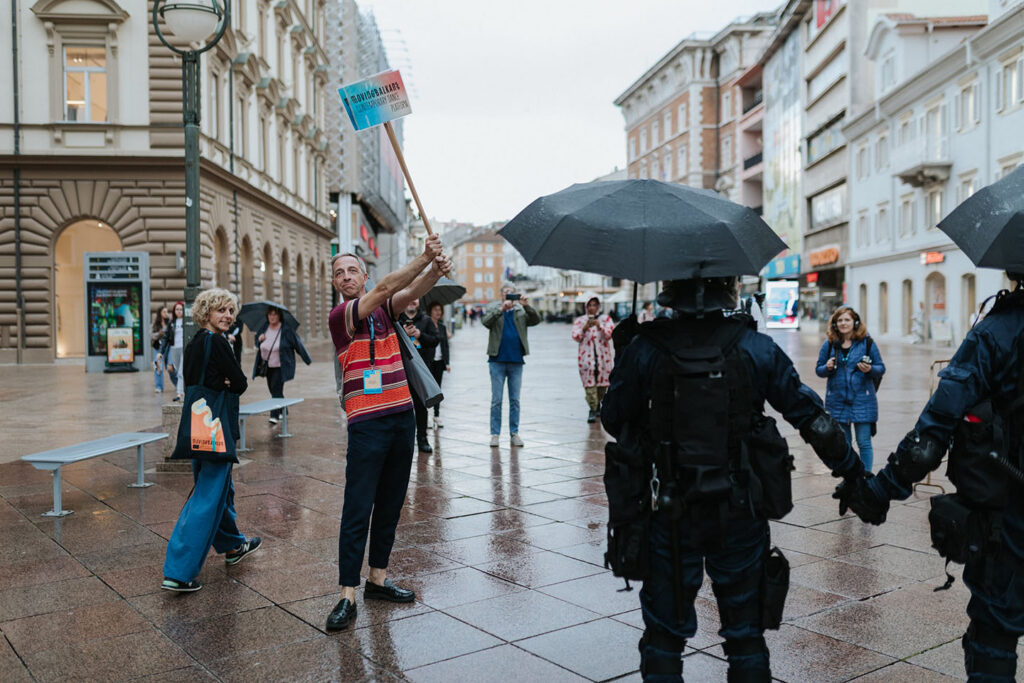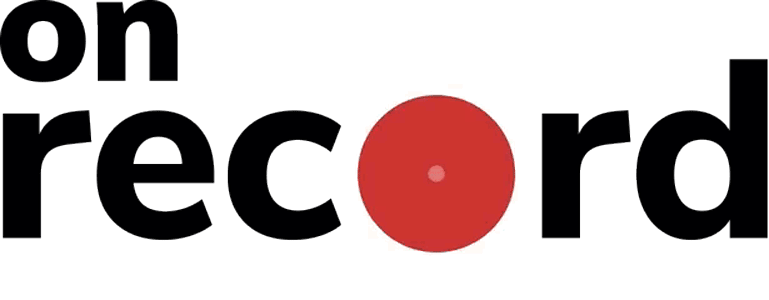
During Moving Balkans, several “Aperitifs with Artists” offered informal moments to chat with choreographers featured in the programme over a glass of wine and a generous buffet. For programmers, these gatherings often meant diving into production logistics. But for me, as a journalist, they were the perfect setting to explore a question that had been on my mind since the platform began:
What threads, if any, connect the diverse choreographic voices emerging from this vast and varied region of 12 countries?
Three artists shared thoughtful reflections on the social, political, cultural, and artistic currents that shape creation across the Balkans.
Patricia Apergi: “I totally believe in the spirit of what this boiling atmosphere could create”
When I spoke with Athens-based choreographer Patricia Apergi, balancing a plate of cheese on my lap in the foyer of the Ljubljana Puppet Theatre, she described her work The House of Trouble as a “hymn to the human, its diversity, and the freedom to be who you are. It centres everybody that is not average. For me, it’s an exclusive party that says ‘we can have a nice time together even if we are very different.’”
The House of Trouble mainly explores these ideas through krump and voguing, dance styles born in marginalised communities in ’80s New York and ’90s Los Angeles. The circus, a space where violence is often aestheticised and diverse bodies are part of the spectacle, also served as a reference. There’s something about this impulse to create a space where very different—at times volatile—identities can thrive that feels distinctly Balkan.
Though her work highlights individuality, Apergi still sees some common threads among choreographers from her home region. “I think [Balkan artists have] a feeling of non-visibility,” she says. “We belong to Europe, but we feel that we are at the edge of Europe. For me, having a platform that can bring people here and welcome them in our region is very important.”
She also senses a kind of shared artistic DNA. “There are many common things that [Balkan artists share] in [the way] we express ourselves,” she explains, describing a certain loudness and a strong preference for music that “reflects the joy and spirit of life.” Although each country has a very different history, “there is a kind of unifying story, especially in the traditions, tales, and stories we were raised on.”
Apergi also nods to the historical challenges and conflicts that have shaped the region. “You could call it Balkanic [as in volcanic],” she says. “Sometimes these explosions are quite terrifying, but they can also create change. I totally believe in the spirit of what this boiling atmosphere could create. We need to dare to speak out about that, because sometimes we do feel a bit underestimated and less valued than [artists in Northern Europe].”
Stanislav Genadiev: “Every artist can relate to our work and vice versa”
I joined Bulgarian artist Stanislav Genadiev at a table outside a hotel in Rijeka – though on this occasion, I didn’t manage to grab anything to eat. We quickly got into a conversation about how, for him, the Balkans feel very different from Europe. “Whoever says we’re in the European Union, it’s only on paper somehow,” he says. “Bulgarians don’t really feel part of Europe.”
Genadiev sees a lot of similarities between how Balkan companies approach their work, concepts, and aesthetics. “Because the problems we have here are the same everywhere somehow,” he says. “So every artist can relate to our work and vice versa.”
Just before I sat down, Genadiev had been talking to another guest about how in Bulgaria, and the Balkans in general, it’s getting harder to find funding. “There are not so many options,” he says. “There was a period where there were a lot of subsidies for dance… but dance is really under the other arts in Bulgaria somehow. Most of the companies that get big budgets are doing theatre or are big orchestras or operas or stuff like that.”
I mention that one aesthetic commonality I’ve noticed between the works at Moving Balkans is a leaning towards morphing the body, or using materials and costuming to distort the human corpus. Genediev’s work Saline Nebula, created together with Violeta Vitanova, is a prime example, as it features a lone, nude female performer covered in salty and gooey substances, her face covered with a minimalist mask that makes her appear like a dehumanised alien. “We’re mesmerised by working with the body in a non-bodily way,” says Genediev.
Filiz Bozkus Al: “In our culture, it’s obvious that many people are doing things from our hearts”
Feliz Bozkus Al’s solo GONG traces the journey of life through its defining stages, depicting the tumultuousness of the human experience. To do so, it draws heavily on Asian performance culture—Bozkuş Al herself is half Taiwanese—and particularly on Butoh theatre. Bozkuş Al has been an assistant to Japanese Butoh master Iida Shigemi for thirteen years, after taking his Mitakara workshop, which blends Butoh, shamanic practices, martial arts, and Seitei energy techniques to promote healing and eliminate negativity.
This said, Bozkuş Al is also half Turkish, and therefore Balkan. This side of her heritage also influenced the development of GONG. “There is a lot of power in the culture of dance in Turkey,” she says. “In our culture, it’s obvious that many people are doing things from our hearts.” This is most evident for her at weddings and traditional celebrations. “When Turkish people are all dancing together, it’s really coming from the soul and is very free.” This kind of expression is something she sees as being deeply rooted across the Balkans. “We were actually brothers and sisters in the times of the Ottoman Empire.”
The verdict?
As with most complex questions, there was no definitive answer to my musings about a distinct Balkan dance style. Yet what became clear throughout the Aperitifs was that everyone I spoke to was eager to attempt to nurture a sense of kinship among Balkan artists. This sentiment was echoed by Albanian choreographer Gentian Doda. Although I didn’t get the chance to speak with him, he captured the desire for solidarity, and to imbue his choreography with that spirit, perfectly during his pitching session:
“Being Balkan for me is a source of inspiration. I’ve lived in a lot of countries and I’ve traveled a lot, and I feel like a person of the world, someone of nowhere. But I feel Balkan. There is a point of connection between us… in history, in the way of being. It seems like they never wanted us to be together because we are so powerful. We want to connect, we are connecting. We just have to embrace that. Whether I go to Croatia, Macedonia, or Greece, I feel at home.”



